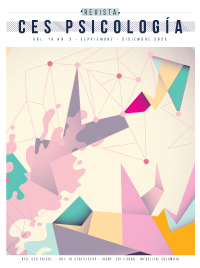Análisis factorial confirmatorio de la Escala verbal de fusión de identidad en una muestra chilena
DOI:
https://doi.org/10.21615/cesp.6165Palabras clave:
fusión de identidad, identidad personal, identidad social, identidad, autosacrificio, comportamiento extremo, estructura factorial, bondad de ajusteResumen
La fusión de identidad consiste en un sentimiento de unión con un grupo, en el que el individuo experimenta una mezcla entre su identidad personal y la social; y es un buen predictor de la conducta extrema progrupo. El presente estudio analizó la estructura factorial de la Escala verbal de fusión de identidad elaborada por Gómez et al. (2011), en una muestra chilena. Se utilizó una muestra universitaria seleccionada por conveniencia de 411 participantes (66% mujeres) con una edad media de 24.45 años (DT = 5.89). Se analizó el ajuste unifactorial y bifactorial de la Escala a través del análisis factorial, y las respectivas confiabilidades. Los resultados indicaron un buen y mejor ajuste del modelo bifactorial (χ2/gl = 3.34, p < .001, CFI = .975, TLI = .957, SRMR = .030, y RMSEA = .085), por sobre el unifactorial, que no mostró un buen ajuste (χ2/gl = 5.26, p < .001, CFI = .946, TLI = .919, SRMR = .042, y RMSEA = .116). Ambos modelos contaron con altas confiabilidades (> .800). Se discutió sobre el mejor ajuste de la estructura bifactorial en relación con estudios realizados en Estados Unidos, España y población inmigrante en Chile. Se proyecta la necesidad de futuros estudios que incorporen otros análisis de validez y superen la limitación del presente estudio asociada al uso de una muestra no representativa.
Descargas
Referencias bibliográficas
Alexandre, N., Gallasch C., Lima M., & Rodrigues R. (2013). Reliability in the development and evaluation of measurement instruments in the health field. Revista Eletrônica de Enfermagem, 15(3), 802-809. http://dx.doi.org/10.5216/ree.v15i3.20776
Ashokkumar, A., Talaifar, S., Fraser, W. T., Landabur, R., Buhrmester, M., Gómez, Á., … Swann W. B. (2020). Censoring political opposition online: Who does it and why. Journal of Experimental Social Psychology, 91, 104031. https://doi.org/10.1016/j.jesp.2020.104031
Besta, T., Gómez, Á., & Vázquez, A. (2014). Readiness to deny group’s wrongdoing and willingness to fight for its members: The role of poles’ identity fusion with the country and religious group. Current Issues in Personality Psychology, 2, 49–55. http://dx.doi.org/10.5114/cipp.2014.43101
Besta, T., Mattingly, B., & Błażek, M. (2015). When membership gives strength to act: Inclusion of the group into the self and feeling of personal agency. The Journal of Social Psychology, 156(1), 56-73. http://dx.doi.org/10.1080/00224545.2015.1053838
Bortolini, T., Newson, M., Natividade, J. C., Vázquez, A., & Gómez, Á. (2018). Identity fusion predicts endorsement of pro-group behaviours targeting nationality, religion, or football in Brazilian samples. British Journal of Social Psychology, 57(2), 346-366. http://dx.doi.org/10.1111/bjso.12235
Buhrmester, M., Fraser, W., Lanman, J., Whitehouse, H., & Swann, W. (2014). When terror hits home: Identity fused Americans who saw Boston bombing victims as ‘family’ provided aid. Self and Identity, 14, 253–270. http://dx.doi.org/10.1080/15298868.2014.992465
Fredman, L., Buhrmester, M., Gómez, Á., Fraser, W., Talaifar, S., Brannon, S., … Swann, W. (2015). Identity fusion, extreme pro-group behavior, and the path to defusion. Social and Personality Psychology Compass, 9, 468-480. http://dx.doi.org/10.1111/spc3.12193
Gómez, Á., Brooks, M., Buhrmester, M., Vázquez, A., Jetten, J., & Swann, W. (2011). On the nature of identity fusion: Insights into the construct and a new measure. Journal of Personality and Social Psychology, 100, 918–933. http://dx.doi.org/10.1037/a0022642
Gómez, Á., Chinchilla, J., Vázquez, A., López‐Rodríguez, L., Paredes, B., & Martínez, M. (2020). Recent advances, misconceptions, untested assumptions, and future research agenda for identity fusion theory. Social and Personality Psychology Compass, 14(6), 1-15. https://doi.org/10.1111/spc3.12531.
Gómez, Á., Morales, J., Hart, S., Vázquez, A., & Swann, W. (2011). Rejected and excluded forever more, but even more devoted: Irrevocable ostracism intensifies loyalty to the group among identity fused persons. Personality and Social Psychology, 100(5), 918–933. https://doi.org/10.1037/a0022642
Gómez, A., & Vázquez, A. (2015). The power of ‘feeling one’ with a group: Identity fusion and extreme pro-group behaviors. International Journal of Social Psychology, 30, 481–511. https://doi.org/10.1080/02134748.2015.1065089
Gómez, Á., Vázquez, A., López-Rodríguez, L., Talaifar, S., Martínez, M., Buhrmester, M. D., … Swann Jr, W. B. (2019). Why people abandon groups: Degrading relational vs collective ties uniquely impacts identity fusion and identification. Journal of Experimental Social Psychology, 85, 1-16. https://doi.org/10.1016/j.jesp.2019.103853
Gosling, S., Vazire, S., Srivastava, S., & John, O. (2004). Should we trust web-based studies? A comparative analysis of six preconceptions about internet questionnaires. American Psychologist, 59(2), 93-104. https://doi.org/10.1037/0003-066X.59.2.93
Hair, J., Anderson, R., Tatham, R., & Black, W. (1999). Análisis multivariante. (5° ed.). Prentice Hall.
Henrich, J., Heine, S. J., & Norenzayan, A. (2010). Most people are not WEIRD. Nature, 466(7302), 29. https://www.nature.com/articles/466029a
Henríquez, D., Urzúa, A., & López-López, W. (2019). Fusión de identidad en migrantes: análisis psicométrico de la escala verbal. Suma Psicológica, 26(2), 86-93. http://dx.doi.org/10.14349/sumapsi.2019.v26.n2.4
Henríquez, D., Urzúa, A., & López-López, W. (2020). Identity fusion: A systematic review. Acta Colombiana de Psicología, 23(2), 383-409. https://doi.org/10.14718/ACP.2020.23.2.15
Jiménez, J., Gómez, Á., Buhrmester, M., Vázquez, A., Whitehouse, H., & Swann, W. (2015). The dynamic identity fusion index: A new continuous measure of identity fusion for web-based questionnaires. Social Science Computer Review, 34, 215–228. https://doi.org/10.1177/0894439314566178
Kong, F. (2017). The validity of the Wong and Law Emotional Intelligence Scale in a Chinese sample: tests of measurement invariance and latent mean differences across gender and age. Personality and Individual Differences, 116, 29–31. https://doi.org/10.1016/j.paid.2017.04.025
Kunst, J. R., Boos, B., Kimel, S. Y., Obaidi, M., Shani, M., & Thomsen, L. (2018). Engaging in extreme activism in support of others’ political struggles: The role of politically motivated fusion with out-groups. PloS one, 13(1), 1-30. https://doi.org/10.1371/journal.pone.0190639
Landabur, R., Miguez, G., Laborda, M., & Salinas, M. I. (2022). Why do people self-sacrifice for their country? The roles of Identity fusion and empathic concern. PsyCh Journal, 11(1), 55-64. https://doi.org/10.1002/pchj.495
Mardia, K. V. (1974). Applications of some measures of multivariate skewness and kurtosis in testing normality and robustness studies. Sankhyā: The Indian Journal of Statistics, 36, 115-128.
Miaja, M., Moral, J., Fonseca, A., Cruz, M., Villarreal, C., Becerril, A., … Ferrigno, A. (2021). Factor structure, internal consistency and distribution of Female Sexual Function Index among Mexican women with early diagnostic of breast cancer. Psicooncología, 18(2), 293-316. https://revistas.ucm.es
Mohsin, N., Mourad, G., Faure, M., Szawarc, I., & Bringer, J. (2013). Metabolic syndrome performs better than the individual factors in predicting renal graft outcome. Transplantation proceedings, 45(10), 3517–3519. https://doi.org/10.1016/j.transproceed.2013.09.013
Muthén, L. K., & Muthén, B. O. (1998-2017). Mplus User’s Guide. (8° ed.). Muthén & Muthén.
Paolacci, G., Chandler, J., & Ipeirotis, P. (2010). Running experiments on Amazon Mechanical Turk. Judgment and Decision Making, 5(5), 411–419. Recuperado de https://repub.eur.nl.
Rosseel, Y. (2012). Lavaan: An R package for structural equation modeling. Journal of Statistical Software, 48(2), 1–36. https://doi.org/10.18637/jss.v048.i02.
Ruiz, M., Pardo, A., & San Martín, R. (2010). Modelos de ecuaciones estructurales. Papeles del Psicólogo, 31(1), 34-45. Recuperado de http://www.papelesdelpsicologo.es.
Schreiber, J. B. (2017). Update to core reporting practices in structural equation modeling. Research in Social and Administrative Pharmacy, 13(3), 634-643. http://dx.doi.org/10.1016/j.sapharm.2016.06.006.
Schreiber, J. B., Nora, A., Stage, F. K., Barlow, E. A., & King, J. (2006). Reporting structural equation modeling and confirmatory factor analysis results: A review. The Journal of Educational Research, 99(6), 323–337. http://dx.doi.org/10.3200/JOER.99.6.323-338.
Swann, W. B., Jr., Buhrmester, M., Gómez, Á., Jetten, J., Bastian, B., Vázquez, A., … Zhang, A. (2014). What makes a group worth dying for? Identity fusion fosters perception of familial ties, promoting self-sacrifice. Journal of Personality and Social Psychology, 106(6), 912–926. https://doi.org/10.1037/a0036089
Swann, W. B., Jr., Gómez, Á., Buhrmester, M., López-Rodríguez, L., Jiménez, J., & Vázquez, A. (2014). Contemplating the ultimate sacrifice: Identity fusion channels pro-group affect, cognition, and moral decision making. Journal of Personality and Social Psychology, 106(5), 713-727. https://doi.org/10.1037/a0035809
Swann, W. B., Jr., Gómez, Á., Dovidio, J., Hart, S., & Jetten, J. (2010). Dying and killing for one’s group: Identity fusion moderates responses to intergroup versions of the trolley problem. Psychological Science, 21, 1176–1183. https://doi.org/10.1177/0956797610376656
Swann, W. B., Jr., Gómez, Á., Seyle, C., Morales, J., & Huici, C. (2009). Identity fusion: The interplay of personal and social identities in extreme group behavior. Journal of Personality and Social Psychology, 96, 995-1011. https://doi.org/10.1037/a0013668
Swann, W. B., Jr., Jetten, J., Gómez, Á., Whitehouse, H., & Bastian, B. (2012). When group membership gets personal: A theory of identity fusion. Psychological Review, 119, 441-456. https://doi.org/10.1037/a0028589
Tajfel, H. (1974). Social identity and intergroup behaviour. Social Science Information, 13(2), 65-93.
Tajfel, H., & Turner, J. (1979). An integrative theory of intergroup conflict. En W.G. Austin y S. Worchel (Eds.), The Social Psychology of intergroup relations (pp. 33-47). Brooks- Cole.
Turner, J.C., & Reynolds, K. (2012). Self-categorization theory. En P. Van Lange, A. Kruglanski & E. Higgins (Eds.), Handbook of Theories of Social Psychology (pp. 399-417). SAGE.
Whitehouse, H., McQuinn, B., Buhrmester, M., & Swann, W. (2014). Brothers in arms: Libyan revolutionaries bond like family. Proceedings of the National Academy of Sciences, 111, 17783-17785. https://doi.org/10.1073/pnas.1416284111
Yzerbyt, V., & Demoulin, S. (2010). Intergroup relations. En S. Fiske, D. Gilbert & G. Lindzey (Eds.), Handbook of Social Psychology (pp. 1024-1083). John Wiley & Sons.
Descargas
Publicado
Cómo citar
Número
Sección
Licencia
Derechos de autor 2022 Rodrigo Landabur Ayala, Gonzalo Miguez Cavieres, Mario Laborda, María Salinas

Esta obra está bajo una licencia internacional Creative Commons Atribución-NoComercial-CompartirIgual 4.0.
Revista CES Psicología ISSN 2011 3080
Facultad de Psicología, Universidad CES Primera edición 2008. Última actualización Mayo 18 de 2022. Todos los derechos reservados. Hecho el depósito legal que exige la ley.
Se autoriza la reproducción total o parcial de los artículos citando la fuente y el autor. This publication may be reproduced by mentioning the source and the authors.
| Estadísticas de artículo | |
|---|---|
| Vistas de resúmenes | |
| Vistas de PDF | |
| Descargas de PDF | |
| Vistas de HTML | |
| Otras vistas | |




